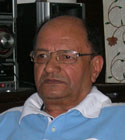DIWALI – THE FESTIVAL OF LIGHTS
October 14th, 2009 by | Posted in Life Comments Off on DIWALI – THE FESTIVAL OF LIGHTS‘Deepawali’ or ‘Diwali’ is certainly the most magnificent of all Hindu festivals. It’s the festival of ‘lights’ that’s marked by four days of celebrations, in which the country is illuminated with brilliance and dazzles everyone with its’ joy. Diwali is celebrated on a nation-wide scale on Amavasya – the 15th day of the dark fortnight of the Hindu month of Ashwin, (October/November) every year. Amongst Hindus, across many parts of India and Nepal, it is the homecoming of Lord Rama after a 14-year exile in the forest after his victory over Ravana. The people of Ayodhya (the capital of his kingdom) welcomed Rama by lighting rows (avali) of lamps (dipa), thus its’ name, ‘dipawali’. This year it falls on 17th October.

Diwali
Every year on the dark nights of Diwali, the sound of fireworks announce the celebrations of the favorite festival of Indians. Homes are decorated and thousands of lamps are lit to create a world of fantasy. Of all the festivals celebrated in India, Diwali is by far the most glamorous and important. It is enthusiastically enjoyed by people of every religion; its’ radiance creates an atmosphere of joy and festivity.
Deepavali has also been a significant festival in Sikhism since the illumination of the town of Amritsar commemorating the return of Guru Har Gobind Ji (1595-1644), the sixth Guru of Sikhism, who was imprisoned along with 52 other Hindu kings at Fort Gwalior by Emperor Jahangir. After freeing the other prisoners, he went to the Darbar Sahib (Golden Temple) in the holy city of Amritsar, where he was welcomed happily by the people who lit candles and divas to greet the Guru.
The ancient stories of why Diwali is celebrated, are different. In UP, Punjab, Haryana and the surrounding areas, Diwali is the day when King Rama’s coronation was celebrated in Ayodhya after his epic war with Ravana, the demon king of Lanka. The royal families of Ayodhya and Mithila ordered that the cities and far-flung boundaries of these kingdoms be lit up with rows of lamps, glittering on dark nights to welcome home the divine King Lord Rama and Ma Sita after 14 years of exile, ending with a war in which the whole of Lanka was destroyed.

Diwali cracker
In each legend and story of Diwali lies the significance of the victory of good over evil and it is with each Diwali and the lights that illuminate our homes and hearts, that this simple truth finds new reason and hope.
A day prior to Diwali most of the families buy new utensils and this day is known as ‘Dhan-teras’. On the day of Diwali festival, doorways are decorated with flowers. Rangolis are drawn with different colored powders to welcome guests outside the main door entrance. The ‘pooja room’ inside the house is also cleaned and decorated with flowers and decorative paperwork which is available ready-made in the market. Oil diyas are arranged in and around the house. All members of the family get together before dinner to pray to the Gods starting with prayers to Lord Ganesha and Goddess Luxmi. The prayer chanted in their honour, is meant to seek wealth and financial stability. The rest of the prayer and aarti follows.
![Diwali Sweets images[11]](https://bedtea.in/wp-content/uploads/2009/10/images111.jpg)
Diwali Sweets
On the day of Deepavali/Diwali, some North Indian business communities start their financial year on Diwali and new account books are opened on this day. According to individual financial status, most families host lavish festive meals as well.
Many families completely clean their homes and throw open their windows, as a way of welcoming the Goddess Luxmi inside their homes.
All the simple rituals of Diwali are significant and have a story to tell. The illumination of homes with lights and the skies with firecrackers is an expression of obeisance to the heavens for the attainment of health, wealth, knowledge, peace and prosperity. According to one belief, the sound of fire-crackers is an indication of the joy of the people living on earth, making the Gods aware of their plentiful state and thanking Him for small mercies.
Happy Diwali to all.
Ravi Matah
Tags: Ayodhya, Crackers, Deepavali, Divali, Golden Temple, Guru Har Govindji, Lord Rama, Sweets


